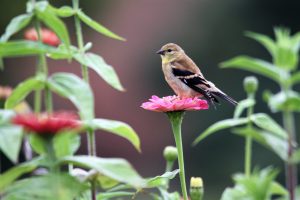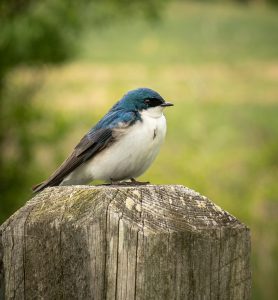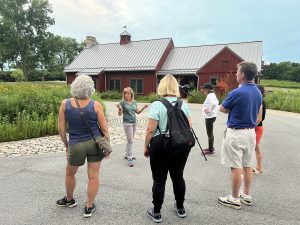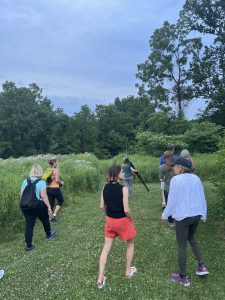What’s Ornitherapy?
Photos by Blake Goll, Gary Gittis, Jennifer Mathes, Monica McQuail and Holly MerkerJust bird-watching + mindfulness

Birds have long captured our attention. And in the last two years, there’s been a noticeable uptick in birders and bird enthusiasts.
For example, during lockdown in 2020, businesses selling bird feeders reported an increase in sales by 45 to 50%. According to the Cornell Lab or Ornithology, Global Bird Day in 2021 yielded a new record in participants and recorded bird sightings with 1 billion observations. And visits to specific bird species on Wikipedia skyrocketed, the number of Audubon Bird Guide app downloads nearly doubled, and Black Birders Week graced our news feeds by highlighting the diversity of Black scientists within the birding world.
With little else to do, many of us morphed into “armchair birders,” perhaps yearning for neighborly companionship or envying a sense of freedom that quite literally flew in stark contrast to our own confinement at the time.
Fascinating Birds
But why birds in particular? “With over 10,000 species and representation on every continent, these living dinosaurs captivate us in all sorts of ways. They are the singing harbingers of spring, their beautiful colors inspire a variety of artwork and poetry, and, well, they’re just fun to watch,” says Blake Goll, Education Programs Manager at Willistown Conservation Trust.
Observe a Carolina chickadee gather moss, fur and other creative insulation to create a blanket that keeps her eggs camouflaged and warm whenever she leaves her nest. Watch a territorial male northern cardinal battle its own reflected image in your window. Become mesmerized by a flock of thousands of starlings swirling across the sky in perfect unison, an eerily beautiful behavior called murmuration.
Try Ornitherapy

Birds have unique personalities and funny behaviors that we can’t help but find intriguing or relatable, and it’s these joyful observations that make up the practice of ornitherapy.
Ornitherapy combines bird-watching with mindfulness. While traditional birding may rely on a “seek and find” approach, where species identification, bird counts or checklists are the goals, ornitherapy gets us out of our heads and off of our screens, and permits us to slow down and exist in the moment with the birds that surround us.
The practice itself is simple: go outside, find a comfortable spot, take a moment to close your eyes and, when you’re ready, begin watching the birds around you. Observe their shapes, colors and the patterns of their movements. Listen to their calls, the different rhythms and their responses.
Replace your field guide and bird list with a journal where you can translate your feelings into words or record your observations with drawings. Put down your phone and camera so you may fully focus on what’s going on above you.
Part of the beauty of ornitherapy is its accessibility. You don’t have to know what kind of bird you’re looking at to appreciate and find joy in it. You can allow yourself to be curious without fully understanding the biology or science to explain a bird’s behavior.
You can also practice ornitherapy from any place you might find birds, including rural and urban areas. Ornitherapy is meant to be enjoyed by yourself or with a group of friends of all ages and at any level of fitness. And best of all — it’s free!
Health Benefits
Similar to the Japanese practice of forest bathing (shinrin-yoku) that was introduced in the 1980s, ornitherapy has a variety of health benefits, including lowering cortisol levels and blood pressure, while improving focus, productivity, creativity and positivity. Simply walking in the woods has been shown to boost our immunity thanks to antimicrobial chemical compounds called phytoncides that are released by trees.
And more recently, doctors have increasingly prescribed nature as viable treatment to help reduce anxiety and stress.
A Local Practitioner

Downingtown native Holly Merker discovered the benefits of ornitherapy after being diagnosed with breast cancer in 2002. She foud respite in nature, observing the birds on her favorite trail and relating t their ability to survive their own hardships. For Holly, nature was nonjudgmental, and the birds were her medicine.
Years later and now cancer-free, Holly has fully embraced the practice, even coauthoring an award-winning book — Ornitherapy: For Your Mind, Body and Soul — that offers observational explorations, meditative practices and journaling inspiration for anyone looking to discover the beauty of mindful birding.
A professional birder herself, Holly found ornitherapy permitted her to discard the stress and anxiety of searching for a “target” bird and allowed her to fully appreciate the common species she often disregarded in search of a more exciting migratory species. As she explains, “Being in the moment with birds redirects our attention to intention.” She hopes practicing ornitherapy will empower participants to connect with birds fully, with the mind, body and soul, and in brand new ways.
Workshops and More
 Holly recently hosted multiple ornitherapy workshops at Willistown Conservation Trust’s Rushton Conservation Center, where she led participants through a guided ornitherapy meditation.
Holly recently hosted multiple ornitherapy workshops at Willistown Conservation Trust’s Rushton Conservation Center, where she led participants through a guided ornitherapy meditation.
Seated on the grass and facing Rushton Farm, stillness and silence gave way to the singing of dazzling birds that swooped over wildflower fields. Participants remarked on the appearance of this symphony that they hadn’t noticed before, and each individual measured a noticeable difference in their stress, energy and contentment after two hours spent in the company of birds.
Whether you’re a lifetime birder or someone who appreciates your feathered neighbors, consider improving your health with a prescription for ornitherapy.
Visit WCTrust.org for upcoming birding events at Willistown Conservation Trust, and head to Ornitherapy.com for all things ornitherapy.
Willistown Conservation Trust focuses on 28,000 acres within the Ridley, Crum and Darby Creeks watershed. Since 1996, the Trust has permanently conserved over 7,500 acres, including three nature preserves open to the public: Ashbridge, Kirkwood and Rushton Woods Preserve, home to Rushton Conservation Center and Rushton Farm. The Trust offers programs for public engagement and research: Bird Conservation, Community Farm, Education and Outreach, Land Protection, Stewardship, and Watershed Protection Programs. WCTrust.org.
